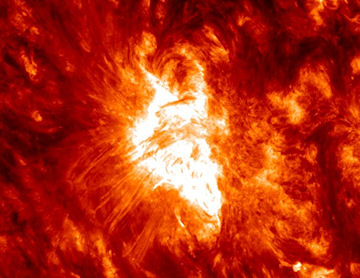ANDROID FLYBYS: Our field-tested satellite tracker is now available for Android phones. Features: Global predictions and flyby alarms! Learn more. | | | LAST X-FLARE: Can you remember the last time the sun produced an X-class solar flare? (Spoiler alert: The answer lies two sentences hence.) X-class flares are the most powerful kind of solar eruption, and during years of solar maximum they can occur on a daily basis. The most recent X-flare occurred on Dec. 14, 2006, almost four years ago. That last gasp of decaying Solar Cycle 23 marked the beginning of a deep solar minimum that is only now coming to an end. When will the first X-flare of Solar Cycle 24 explode? You could be the first to know. ULTRAVIOLET SUNSPOT: Sunspot 1089 is churning out a lot of extreme ultraviolet (EUV) photons. Witness this EUV image taken just hours ago by the Solar Dynamics Observatory: 
The bright glow comes from hot (80,000 K) plasma trapped by the sunspot's magnetic field. All by itself, this one 'hot spot' is lifting the EUV brightness of the entire sun toward a high point for the year. EUV photons from sunspot 1089 are absorbed in Earth's upper atmosphere where they heat the rarefied air and help reverse the recent collapse of the thermosphere. Sunspot 1089 is still growing, both in brightness and area. Readers with solar telescopes are encouraged to monitor developments. IRIDESCENT HAIR DAY: "I was playing mini-golf with my daughter today when we noticed a beautiful iridescent corona around the sun," reports Jesper Grønne of Denmark. Kneeling in his daughter's shadow on the 7th green, he recorded the phenomenon: 
"The breeze lifted her hair toward the clouds, making my daughter herself appear to be part of the display." Coronas appear when the sun shines through tiny droplets of water or sometimes small ice crystals in high clouds. Diffraction of sunlight creates rings of pastel color, which crowd around the disk of the sun. Look for them any time thin clouds drift across the sun. Bonus observing tip: Polarizing lenses make the colors of iridescent clouds more vivid and therefore easier to find and enjoy.
Solar Eclipse Photo Gallery
[NASA: South Pacific Eclipse] [animated map] | 
